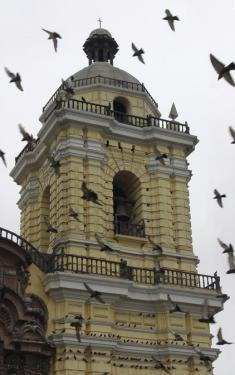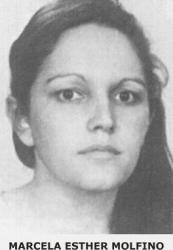%%rimage[The junta's concordat still binds Peru today]=X17661_727_PELimaConventoSFranLogo_t55.jpg The junta's concordat still binds Peru today
The 1980 concordat with the military junta of Peru was hastily ratified just 2 days before the new democratic constitution came into effect. Now the Protestants, in an attempt to get a law which gives them more privileges, have agreed not to criticise the concordat and to permit dropping any mention of a “secular state” in the new legislation.
 For the Vatican it was a cliff-hanger. Could it get the concordat through before the military junta departed? This is why the concordat became a part of Peruvian legislation even before it was ratified: on 24 July 1980 the concordat text was made into law through a decree signed by the leading members ofthe military junta [1]. Of the decree's signatories, the first two generals are currently being sought by an Italian court to answer murder charges. [2]
For the Vatican it was a cliff-hanger. Could it get the concordat through before the military junta departed? This is why the concordat became a part of Peruvian legislation even before it was ratified: on 24 July 1980 the concordat text was made into law through a decree signed by the leading members ofthe military junta [1]. Of the decree's signatories, the first two generals are currently being sought by an Italian court to answer murder charges. [2]
♦ General Francisco Morales Bermúdez (President)
♦ General Pedro Richter Prada (Prime Minister)
♦ Lt. General Luis Arias Graziani (President of the Joint Command of the Armed Forces)
♦ Vice-Admiral Juan Egúsquiza Babilonia (Minister of the Navy)
♦ Ambassador Arturo García y Garcia.
A couple of days later, on 26 July, the concordat was finally ratified and a couple of days after that, on 28 July 1980 a new democratic constitution came into effect which said that only Congress — not a junta of generals — could make financial treaties. [3]
While the concordat was rished through, the Peruvian junta helped Argentina's terror regime
According to the respected IPS it was in June 1980, precisely when this concordat was being hastily prepared, that Peru's junta made its last contribution to “Operation Condor” which was created by the military regimes ruling South America in the 1970s and 1980s to cooperate in killing dissidents. This was “a covert strategy that entailed information sharing and joint operations between the intelligence services of Argentina, Bolivia, Brazil, Chile, Paraguay and Uruguay to kidnap, murder and ‘disappear’ leftists and other alleged ‘subversives’.” [4]
 In Argentina opposition to their junta was mounted by the human rights group called the Mothers of the Plaza de Mayo. Almost alone in defying the military, these women risked their lives by demonstrating every week in the Plaza, seeking information about their children who had vanished into the torture chambers and the sea. Among the mothers was Noemí Gianetti de Molfino whose daughter Marcela had been "disappeared" by the Junta in 1979. In 1980, as the concordat was being prepared, Noemí, fled Argentina, but she was hunted down in Lima by the Peruvian Junta. [5] Her body was found on 21 July 1980.
In Argentina opposition to their junta was mounted by the human rights group called the Mothers of the Plaza de Mayo. Almost alone in defying the military, these women risked their lives by demonstrating every week in the Plaza, seeking information about their children who had vanished into the torture chambers and the sea. Among the mothers was Noemí Gianetti de Molfino whose daughter Marcela had been "disappeared" by the Junta in 1979. In 1980, as the concordat was being prepared, Noemí, fled Argentina, but she was hunted down in Lima by the Peruvian Junta. [5] Her body was found on 21 July 1980.
(Postscript: in November 2009 a young man began to wonder if he was really the son of an Argentine intelligence agent, had his DNA tested by what are now the “Grandmothers of the Plaza de Mayo” and discovered that he was Marcela's son, born in her captivity. His mother and father were never heard from again and his grandmother had been kidnapped and murdered after protesting his mother's disappearance, but at least he found that he had three surviving brothers.) [6]
Democracy returns, but the Junta's concordat remains
On 28 July 1980 the democratically-elected president assumed office and the nightmare was finally over. But the dictator had committed the country to a concordat two days before he left and that remains in force today. The Peruvian concordat with the military junta is just one of many concluded with despots, large and small, such as Hitler, Mussolini, Franco, Duvalier, Trujillo, Dollfuss, Houphouët-Boigny, Aramburu and Onganía. (Rightwing) dictators tend to give the Church far better terms than democracies do. In Peru the Vatican managed it with only two days to spare — but that was sufficient.
Protestant opposition to the concordat dropped
The Peruvian Protestants had been lobbying for a law to promote more religious freedom and equality with the Catholic Church. [7] As in Brazil, they have let their desire to share some of the privileges given to the Catholics neutralise their opposition to the concordat. In the course of the negotiations, the Protestants agreed in March 2010 that the law they sought would have no bearing on the concordat. It has even been reported on their website that they are willing to delete from the draft law all mention of the principle of church-state separation (i.e., a "secular state/Estado Laico") which would threaten the concordat. [8] Some Peruvians are left wondering what right these churches have to "negotiate" about a legal principle that affects everyone.
The junta's concordat lives on
The following excerpts from the US State Department's International Religious Freedom Report on Peru for 2009 hints at some of the consequences of the concordat — huge state subsidies for the Church, pupils obliged to take Catholic religion classes in state schools if they want good marks, and massive Church influence in the military.
The Constitution specifically prohibits discrimination based on religion, but the Catholic Church receives preferential treatment in education, tax benefits, immigration of religious workers, and other areas, in accordance with the 1980 agreement. All work-related earnings of Catholic priests and bishops are exempt from income taxes. Some Catholic clergy and laypersons receive remuneration from the State in addition to the stipends paid to them by the Church. This applies to the country's 49 active bishops, as well as to some priests whose ministries are located in towns and villages along the borders, representing approximately an eighth of the clergy. [...] Ministry of Justice officials stated that the Government pays stipends to the Catholic cardinal, six archbishops, and other Catholic Church officials. According to the Office of Catholic Affairs, the Government gives the Catholic Church approximately $867,700 (PEN 2,603,000) annually. [...] In addition, each diocese receives a monthly institutional subsidy from the Government. [...]
The law mandates that all schools, public and private, impart religious education as part of the curriculum throughout the education process (primary and secondary), "without violating the freedom of conscience of the student, parents, or teachers." Catholicism is the only religion taught in public schools. [...] Non-Catholic organizations complained that although their adherents were exempt from attending Catholic instruction, students who did so lost academic credits. Students who graduated from primary and secondary schools without these credits could not be at the top of their class, regardless of other academic achievements, and were thus disadvantaged in competition for scholarships and for admission to universities.
By law the military may employ only Catholic clergy as chaplains, and Catholicism is the only recognized religion for military personnel. A 1999 government decree creating 40 Catholic military positions obliges members of the armed forces and the police, as well as relatives and civilian coworkers, to participate in Catholic services.
Notes
1. http://destp.minedu.gob.pe/docum/dly-23211.doc See the translation of the discreet note added in Latin at the end of the concordat text, which shows that the document wasn't ratified until 26 July 1980.
2. Ángel Páez, “Peru: Operation Condor Tentacles Stretched Even Farther”, IPS, 8 January 2008. http://ipsnews.net/news.asp?idnews=40714
3. Article 56: "...deben ser aprobados por el Congreso los tratados que crean, modifican o suprimen tributos"."Constitución Política del Perú, sancionada por la Asamblea Constituyente el 12 de julio de 1979 y puesta en vigencia con el cúmplase correspondiente el 28 de julio de 1980 por el presidente de la República, Fernando Belaunde Terry".
De 28 de julio de 1980 hasta la fecha". http://www.garciabelaunde.com/biblioteca/LasConstitucionesdelPeru.pdf
4. Ángel Páez, “Peru: Operation Condor Tentacles Stretched Even Farther”, IPS, 8 January 2008. http://ipsnews.net/news.asp?idnews=40714
5. Ibid.
6. “Grandmothers of Plaza de Mayo find grandson number 98”, Moment 24, 3 November 2009. http://momento24.com/en/2009/11/03/grandmothers-of-plaza-de-mayo-find-grandson-number-98/
7. The Protestant groups negotiating are the two major evangelical umbrella organizations, the National Evangelical Council of Peru (CONEP, founded in 1940) and the Union of Evangelical Christian Churches of Peru (UNICEP, founded in 2003).
The interfaith working group [of non-Catholic religious groups] continued to advocate for a law to promote further religious freedom and equality. On June 11, 2009, thousands of evangelicals and supporters marched to Congress to draw attention to draft law 1008/2006 - CR Law on Religious Freedom and Equality.
United States Department of State, 2009 Report on International Religious Freedom - Peru, 26 October 2009. http://www.unhcr.org/refworld/country,,,,PER,4562d94e2,4ae861146e,0.html
8. "A pocas horas de la Ley de Libertad Religiosa" ("A few hours after the Religious Freedom Act"), Reespublica: Red Evanglelica Estatal, 16 March 2010. http://reespublica.blogspot.com/2010/03/reespublica-pocas-horas-de-la-ley-de.html
The "Decreto-Ley 23211" discreetly mentioned in the statement is the law which brought in the concordat. http://destp.minedu.gob.pe/docum/dly-23211.doc







